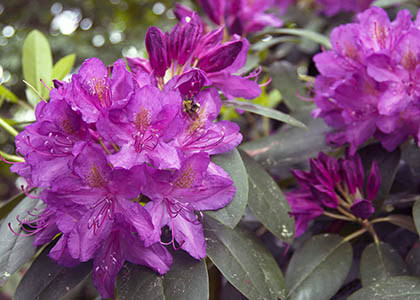
Sometimes there’s a place for the good old tried and true—especially for rhododendrons around Ithaca, New York.
In the mid-1800s a lot of rhododendron hybrids were developed in England and eventually made their way to the U.S. Many of these ended up in the Arnold Arboretum where they were trialed for winter hardiness. E. H. Wilson worked there for many years, and he came up with a list of 12 of the best of these hybrids. This list became known as Wilson’s Dozen or Wilson’s Ironclads.
In the years and decades that followed, many new species of rhododendrons were discovered and many more hybrids developed. The older Ironclads basically fell out of style, supplanted by the latest and the greatest, like the hybrids Charles Dexter was working on in the 1940s. Some of these Ironclad rhododendrons are still readily available, such as Rhododendron ‘Roseum Elegans’, R. ‘Album Elegans’, R. ‘Catawbiense Album’; but many are not.
At Cornell Botanic Gardens we have several, but not all, of these old varieties in our collections, including those named above and also Rhododendron catawbiense ‘Purpureum Elegans’ and R. ‘Mrs C S Sargent’. Year after year, these older types bloom beautifully and maintain an overall solid, healthy appearance. They are rugged, pretty, cold-hardy rhododendrons. Ironclads.
This is not to say that I don’t like newer varieties. Hardly. Some of the hybrids developed by Charles Dexter are wonderful, like the pink Rhododendron ‘Scintillation’ and R. ‘Janet Blair’ (which may be connected to another famous hybridizer, David Leach); R. ‘Boule de Neige’ and R. ‘Nova Zembla’ are also excellent white and red plants.
However, Ithaca is in a funny spot: just outside of where rhododendrons naturally want to grow; just outside of the soils they like; and just outside of temperatures they really prefer. Yet Ithaca is an excellent place to still grow the tried-and-true Ironclads. For the last century they have been solid performers.
Climate change remains with us, and still affects the entire planet. Our attention right now is on racial inequality, and public health, but the environmental issues we all face have not gone away. Perhaps these Ironclads will continue to be beautiful, thriving plants we can still enjoy, even as the climate continues to change. Let’s see how Ironclad they continue to be in the century to come.
Phil Syphrit is the horticulturist at Cornell Botanic Gardens responsible for its Bowers Rhododendron Collection